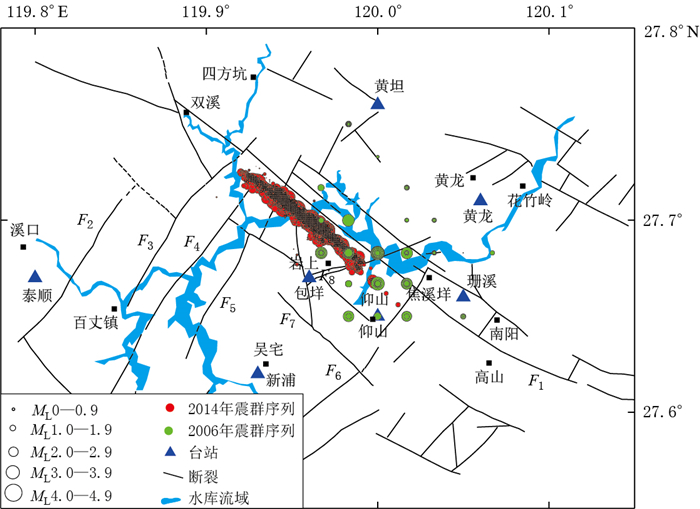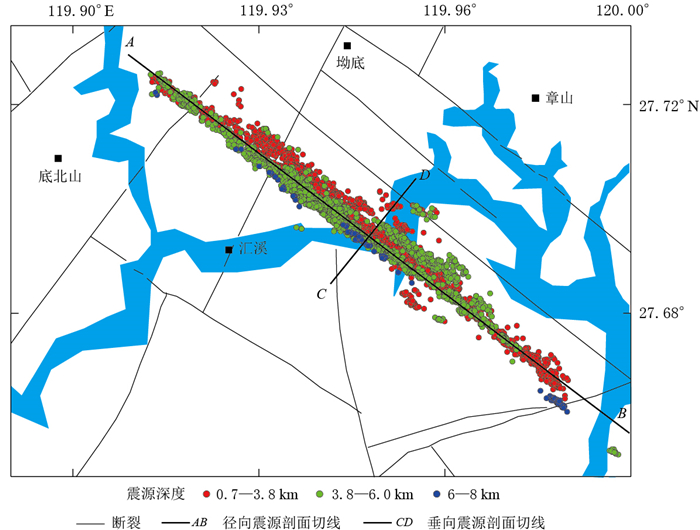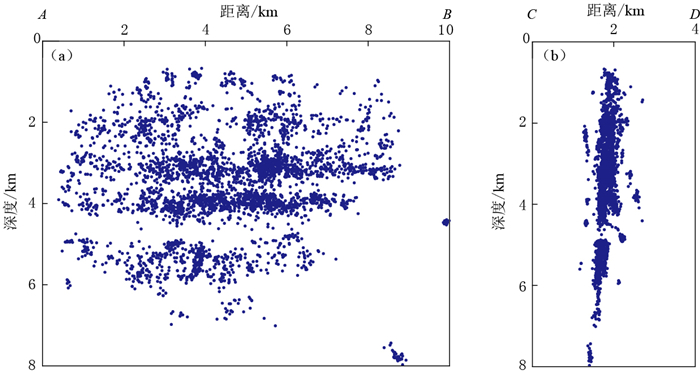Investigation on the seismogenic mechanism of the 2014 earthquake swarm in Shanxi reservoir, Zhejiang Province
-
摘要: 本文使用双差定位法对2014年9月12日至12月30日浙江珊溪水库发生的4184次地震进行重定位,并采用CAP方法对11次ML≥3.0地震事件的震源机制解进行反演,讨论了震群序列的活动特征及其与断裂之间的关系,分析了水库水位与地震之间的关系.重新定位的结果显示,在空间分布上,2014年震群序列发生在2006年震群序列NW向延伸的方向上,两者形成一条线性条带,该条带平行分布于双溪—焦溪垟断裂南侧.重定位得到的震源主要在0.7—6 km深度范围内分层分布,垂直于地震条带走向的震源剖面刻画出的结构面以高角度倾向SW.震源机制解结果显示多数地震为走滑型,均存在一个与地震条带走向一致的NW向节面,呈右旋走滑错动性质.考虑到断裂的定位误差,线性分布的震群活动极有可能沿双溪—焦溪垟断裂的破裂面活动,精定位的震源位置和震源机制刻画出了该断裂的几何结构和活动性质.但由于多数地震的震源深度在6 km以上,因此震群活动不能归为双溪—焦溪垟断裂活动的结果,即双溪—焦溪垟断裂不是这两次震群的发震构造,而且仍然属于水库诱发地震,而水库地震存在激发该断裂发生构造地震的可能.水库水位上升或者下降与震群活动关系不大,震群活动有随时间进一步增强的趋势, 可能是库水沿库底断层破裂面长期渗透和扩散增加了孔隙压所致.Abstract: We relocated 4184 earthquakes that occurred in Shanxi reservoir, Zhejiang Province from 12 September to 30 December, 2014 by using double-difference algorithm and determined the focal mechanism solutions of 11 ML≥3.0 earthquakes using the method of CAP in this paper. Based on the analysis of the high-resolution hypocenters and focal mechanisms, we investigated the activity features of the earthquake swarm and its relationship with the fault. On the mapping view, the epicenters of the 2014 earthquake swarm occurred in the extended northwest direction of 2006 seismic swarm belt, which forms a linear belt, running parallel to the south of the Shuangxi-Jiaoxiyang fault. The relocated hypocenters mainly distribute in layers from 0.7 to 6 km in depth. The cross section profile which is perpendicular to the seismic belt strike shows that the seismic plane dips to southwest with a high angle. Most focal mechanisms are strike-slip type. The nodal planes of the focal mechanism solutions that share the same orientation with the trend of the seismic belt distribution of NW show the feature of dextral strike-slip. Taking the fault location error into consideration, the earthquake swarm may align along the rupture plane of the Shuangxi-Jiaoxiyang fault. The high-resolution hypocenters and focal mechanisms delineate the structure and activity nature of the fault. Since there is no distinctive main shock in the earthquake swarm and most earthquakes locate above 6 km in depth, so we can conclude that the earthquake swarm was not caused by the activity of the Shuangxi-Jiaoxiyang fault, but induced by the reservoir water storage. However, it is possible that the Shuangxi-Jiaoxiyang fault may be activated by the water storage of reservoir to generate tectonic earthquake in the future. No evidence shows that there is obvious relationship between the level of the reservoir water storage and seismicity, and the swarm activity becomes greater with time, which may be caused by the pore pressure increasement due to the long term penetration of the reservoir water to the fault plane.
-
浙江省地震局震害防御中心高级工程师赵冬提供了库区断层分布图,中国地震局地震预测研究所“区域地震台网震源参数测定软件编制”项目组提供了SEIS_CAP反演程序,浙江省地震监测预报研究中心提供了波形数据及地震目录,作者在此一并表示真诚的谢意!
-
图 1 2006年和2014年震群台网定位震中分布及库区断层分布图
F1:双溪—焦溪垟断裂;F2:百丈坑—蝉头断裂;F3:百丈口—排前断裂;F4:洪口—章坑断裂;F5:江口—汇溪断裂;F6:南浦—焦溪垟断裂; F7:东坑—章坑断裂;F8:岩上断裂
Figure 1. Epicenter distribution of the 2006 and 2014 earthquake swarms and the faults in Shanxi reservoir region
F1: Shuangxi-Jiaoxiyang fault; F2: Baizhangkeng-Chantou fault; F3: Baizhangkou-Paiqian fault; F4: Hongkou-Zhangkeng fault; F5: Jiangkou-Huixi fault; F6: Nanpu-Jiaoxiyang fault; F7: Dongkeng-Zhangkeng fault; F8: Yanshang fault
图 4 2014年10月25日ML4.4地震观测波形图(黑色)与理论地震图(红色)的比较
台站名下方两个数字分别表示震中距(单位:km)和P波实际到时与理论到时差(单位:s), 波形下方第一行数值为观测值与理论到时差(单位:s), 第二行数值为二者的相关系数
Figure 4. The comparison between the observed waveforms (black) and the synthetic seismograms (red) of the ML4.4 earthquake occurred on October 25, 2014
The station codes are given at the left of the waveforms with epicentral distance (in km) and the difference of the P wave arrival times between observed and calculated values (in s) below. The first line below the waveform is the difference of the arrival times between observed and calculated values (in s), and the second line is the correlation coefficient between the previous two
表 1 Crust2.0地壳速度模型
Table 1 The Crust2.0 velocity model
层厚
/kmvP
/(km·s-1)vS
/(km·s-1)介质密度
/(g·cm-3)21 6.01 3.5 2.75 12 6.88 3.6 2.80 0(莫霍面) 7.98 4.6 3.35 表 2 珊溪水库2014年震群11次ML≥3.0地震震源机制解
Table 2 The focal mechanisms of eleven ML≥3.0 earthquakes in the 2014 earthquake swarm of Shanxi reservoir
发震时刻 ML 节面Ⅰ 节面Ⅱ P轴 T轴 B轴 月-日 时:分 走向
/°倾角
/°滑动角
/°走向
/°倾角
/°滑动角
/°方位角
/°倾角
/°方位角
/°倾角
/°方位角
/°倾角
/°09-17 20:47 3.5 308.7 72.1 172.6 41.0 83.0 1.0 173.9 7.5 266.1 17.7 61.6 70.7 09-23 13:20 4.2 311.0 81.0 173.0 42.1 83.1 9.1 176.4 1.5 266.7 11.3 79.1 78.6 09-23 17:40 3.7 309.2 83.2 164.9 41.0 75.0 7.0 355.8 5.7 264.3 15.5 105.5 73.5 09-27 08:30 4.1 38.0 83.0 10.0 306.8 80.1 172.9 172.2 2.1 262.6 12.0 72.7 77.8 09-27 08:41 3.5 119.0 60.0 150.0 225.1 64.3 33.7 351.2 2.7 83.6 41.3 258.1 48.6 10-03 11:42 4.0 311.0 71.0 174.0 43.0 84.3 19.1 175.7 9.2 268.5 17.5 58.9 70.1 10-15 15:49 4.0 39.0 83.0 -1.0 129.1 89.0 -173.0 354.3 5.7 263.9 4.2 137.2 82.9 10-25 18:42 4.4 311.0 81.0 -21.0 44.4 69.3 -170.4 266.1 21.5 359.2 8.0 108.8 67.2 10-25 19:29 3.8 310.0 81.0 172.0 41.3 82.1 9.1 175.6 7.1 265.7 12.0 81.9 78.0 10-26 07:03 3.4 118.0 77.0 163.0 211.9 73.4 13.6 165.4 2.4 74.5 21.1 261.7 68.7 10-30 19:25 3.3 130.0 63.0 161.0 228.9 73.1 28.3 357.7 6.7 91.8 31.7 257.2 57.4 -
陈希圣. 1993.陕西石泉ML4.7地震成因探讨[J].西北地震学报, 15(2): 76-80. http://en.cnki.com.cn/Article_en/CJFDTOTAL-ZBDZ199302011.htm Chen X S. 1993. Study on cause of formation of the Shiquan earthquake (ML4.7)[J]. Northwestern Seismological Journal, 15(2): 76-80 (in Chinese). http://en.cnki.com.cn/Article_en/CJFDTOTAL-ZBDZ199302011.htm
程惠红, 张怀, 朱伯靖, 郑亮, 石耀霖. 2013.卡里巴水库蓄水引起库区应力场变化影响分析[J].地震, 33(4): 32-42. http://en.cnki.com.cn/Article_en/CJFDTOTAL-DIZN201304006.htm Cheng H H, Zhang H, Zhu B J, Zheng L, Shi Y L. 2013. Stress field changes after the impoundment of Kariba Reservoir[J]. Earthquake, 33(4): 32-42 (in Chinese). http://en.cnki.com.cn/Article_en/CJFDTOTAL-DIZN201304006.htm
华卫, 陈章立, 郑斯华, 晏纯清. 2012.水库诱发地震与构造地震震源参数特征差异性研究:以龙滩水库为例[J].地球物理学进展, 27(3): 924-935. doi: 10.6038/j.issn.1004-2903.2012.03.013 Hua W, Chen Z L, Zheng S H, Yan C Q. 2012. Differences existing in characteristics of source parameters between reservoir induced seismicity and tectonic earthquake: A case study of Longtan reservoir[J]. Progress in Geophysics, 27(3): 924-935 (in Chinese). doi: 10.6038/j.issn.1004-2903.2012.03.013
张帆, 朱新运, 钟羽云. 2013.珊溪水库地震小震震源机制解特征研究[J].地震工程学报, 35(3): 684-691. http://d.wanfangdata.com.cn/Periodical/xbdzxb201303044 Zhang F, Zhu X Y, Zhong Y Y. 2013. Study on the characteristic of focal mechanism solutions of the Shanxi reservoir earthquake[J]. China Earthquake Engineering Journal, 35(3): 684-691 (in Chinese). http://d.wanfangdata.com.cn/Periodical/xbdzxb201303044
钟羽云, 张震峰, 阚宝祥. 2010.温州珊溪水库地震重新定位与速度结构联合反演[J].中国地震, 26(3): 265-272. http://d.wanfangdata.com.cn/Periodical/zgdz201003002 Zhong Y Y, Zhang Z F, Kan B X. 2010. Simultaneous inversion of earthquake relocation and velocity structure in the Shanxi-reservoir, Wenzhou[J]. Earthquake Research in China, 26(3): 265-272 (in Chinese). http://d.wanfangdata.com.cn/Periodical/zgdz201003002
钟羽云, 张帆, 赵冬. 2011.珊溪水库ML4.6震群精确定位与发震构造研究[J].地震研究, 34(2): 158-165. http://kns.cnki.net/KCMS/detail/detail.aspx?filename=dzyj201102009&dbname=CJFD&dbcode=CJFQ Zhong Y Y, Zhang F, Zhao D. 2011. Precise relocation and seismogenic structure of the Shanxi reservoir earthquake sequence in Wenzhou, Zhejiang Province[J]. Journal of Seismological Research, 34(2): 158-165 (in Chinese). http://kns.cnki.net/KCMS/detail/detail.aspx?filename=dzyj201102009&dbname=CJFD&dbcode=CJFQ
钟羽云, 张震峰, 阚宝祥. 2015.珊溪水库地震波速比时空分布特征[J].大地测量与地球动力学, 35(5): 871-875. http://kns.cnki.net/KCMS/detail/detail.aspx?filename=dkxb201505037&dbname=CJFD&dbcode=CJFQ Zhong Y Y, Zhang Z F, Kan B X. 2015. The temporal and spatial distribution characteristics of seismic wave velocity ratio in Shanxi reservoir[J]. Journal of Geodesy and Geodynamics, 35(5): 871-875 (in Chinese). http://kns.cnki.net/KCMS/detail/detail.aspx?filename=dkxb201505037&dbname=CJFD&dbcode=CJFQ
朱新运, 张帆, 于俊谊. 2010.浙江珊溪水库地震精细定位及构造研究[J].中国地震, 26(4): 380-390. http://d.wanfangdata.com.cn/Periodical/zgdz201004003 Zhu X Y, Zhang F, Yu J Y. 2010. Study on precise positioning and structure of the Shanxi reservoir earthquake, Zhejiang Province[J]. Earthquake Research in China, 26(4): 380-390 (in Chinese). http://d.wanfangdata.com.cn/Periodical/zgdz201004003
邹振轩, 李金龙, 俞铁宏, 王政. 2010.温州珊溪水库地震S波分裂研究[J].地震学报, 32(4): 423-432. http://www.dzxb.org/Magazine/Show?id=27302 Zou Z X, Li J L, Yu T H, Wang Z. 2010. A study on S-wave splitting using waveform data from Shanxi reservoir induced earthquakes in Wenzhou of China[J]. Acta Seismologica Sinica, 32(4): 423-432 (in Chinese). http://www.dzxb.org/Magazine/Show?id=27302
Audin L, Avouac J, Flouzat M, Plantet J. 2002. Fluid-driven seismicity in a stable tectonic context: The Remiremont fault zone, Vosges, France[J]. Geophys Res Lett, 29(6): 1091. doi: 10.1029/2001GL012988.
Hill D P. 1977. A model for earthquake swarms[J]. J Geophys Res, 82: 347-352. http://d.wanfangdata.com.cn/OAPaper/oai_doaj-articles_370222c33a13769c23fa9c2355c1017a
Johnson P, McEvilly T. 1995. Parkfield seismicity: Fluid-driven?[J]. J Geophys Res, 100(B7): 12937-12950. doi: 10.1029/95JB00474
Lay T, Wallace T. 1995. Modern Global Seismology[M]. New York: Springer: 393.
Liu S M, Xu L H, Talwani P. 2011. Reservoir-induced seismicity in the Danjiangkou Reservoir: A quantitative analysis[J]. Geophys J Inter, 185: 514-528. doi: 10.1111/gji.2011.185.issue-1
Noir J, Jacques E, Békri S, Adler P M, Tapponnier P, King G C P. 1997. Fluid flow triggered migration of events in the 1989 Dobi earthquake sequence of central Afar[J]. Geophys Res Lett, 24: 2335-2338. doi: 10.1029/97GL02182
Parotidis M, Rothert E, Shapiro S A. 2003. Pore-pressure diffusion: A possible triggering mechanism for the earthquake swarms 2000 in Vogtland/NW-Bohemia, central Europe[J]. Geophys Res Lett, 30(20): 2075. doi: 10.1029/2003GL018110.
Roche V, Baan M. 2015. The role of lithological layering and pore pressure on fluid-induced microseismicity[J]. J Geophys Res, 120: 923-943. doi: 10.1002/2014JB011606.
Saccorotti G, Ventura G, Vilardo G. 2002. Seismic swarms related to diffusive processes: The case of Somma-Vesuvius volcano, Italy[J]. Geophysics, 67: 199-203. doi: 10.1190/1.1451551
Sibson R H. 1987. Earthquake rupturing as a mineralizing agent in hydrothermal systems[J]. Geology, 15(8): 701-704. doi: 10.1130/0091-7613(1987)15<701:ERAAMA>2.0.CO;2
Sibson R H. 1996. Structural permeability of fluid-driven fault-fracture meshes[J]. Struct Geol, 18(8): 1031-1042. doi: 10.1016/0191-8141(96)00032-6.
Waldhauser F, Ellsworth W L. 2000. A double-difference earthquake location algorithm: Method and application to the Northern Hayward fault[J]. Bull Seismol Soc Am, 90: 1352-1368. doi: 10.1785-0120000006/
Yukutake Y, Takeda T, Obara K. 2008. Fine fault structure of a moderate earthquake in the 2007 earthquake sequence of Northen Mie, Japan[J]. Earth Planet Space, 60: 981-985. doi: 10.1186/BF03352854
Zhao L, Helmberger D V. 1994. Source estimation from broadband regional seismograms[J]. Bull Seismol Soc Am, 84(1): 91-104. http://d.wanfangdata.com.cn/NSTLQK/NSTL_QKJJ027969581/
Zhu L P, Helmberger D V. 1996. Advancement in source estimation techniques using broadband regional seismograms[J]. Bull Seismol Soc Am, 6(5): 1634-1641.





 下载:
下载:






